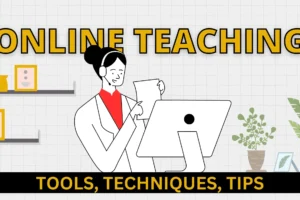
How to Make an Online Course: Preparations and Tips
This is high time for you to share your expertise with the world in the form of online courses. Online courses are growing in demand and even at a lightning-fast pace after the global pandemic caused by COVID-19. At this point, almost everyone is clear on the prospects and benefits of online courses. However, the question “How to make an online course?” comes in the mind naturally. Take a look at this guide to learn the basics so that you can create your very own online course.
Before we move to the details, let us be clear that this guide is focused on those who have institutional support to shoot and edit the course lessons and will only cover the preparations that an online instructor should take to ready the course contents and assessments. If you wish to utilize your own setup for shooting, recording, and editing your course lessons, please go through these thorough guidelines.
Initial Preparations for Making an Online Course
Since you have the option to get support on shooting, recording, and editing the lesson videos, your first job is to decide on how you wish to deliver the course to make your online course lessons effective. There are many variants that can be considered here but here are the few common modes of delivery:
- Standing in front of a Board (Digital/Black/White Board) presenting your topic with a few annotations if required
- Presenting on a PC recording yourself in a webcam and the contents through screen recording
- Presenting on a PC with screen recording just focusing on the content and without recording yourself
- Only recording your voice narration of the topic
Deciding on the modes of delivery early can help your studio to arrange all the required logistics and make the process a lot easier and quicker. Now let us discover which method you can apply for what situation.
The first option is for those who have decided to present a complex topic like mathematics or science where you need to annotate a lot or draw diagrams or pictures to make the topic clear to the learners. The second and third option is for technical subjects but for topics that can be explained by presenting PowerPoint slides or by presenting the process from a PC screen. Depending on your personal preference you may decide whether to use the second or third option. The fourth option is suitable for topics that are mostly theoretical and your voice narration is enough to make the learners aware or learn about the topic.
Material Development
For preparing your materials, you need to first decide on the course name, course outline, and assessment. Let us see the process in detail and step by step below:
Planning Course Name or Title is the first priority. Your course name or title can be the deciding factor on whether your course will succeed or not. So, plan for a good and catchy title for your course but at the same time keep it relevant to the topic and course objective. To learn more about how you can select a good title for your course, you can visit these guidelines from Thinkific. You can also utilize some online web applications that can help you generate your course name. Weshare.net can be one such example.
A course outline is similarly important. It is the first impression of a learner about the course. Almost all platforms make the course curriculum or outline visible to develop the confidence of the learners to take the course. So, after confirming a good name for the course, plan how would you break down the topic of the course. It is better to segment the course into several chapters or units and then break down those chapters or units into several lessons or steps. How effective your course can highly depend on how well you can organize the chapters and lessons.
You might ask why initiate chapters for your online course and why not just course lessons? Well, it is because through these chapters learners will get the feeling of achievement from the course continuously till they finish the course. It may not be that much effective for shorter courses but for longer courses, learners may feel that they have to complete the whole course before they feel the achievement of completing the course. On the other hand, a learner will feel that they can learn at least a chunk of an important segment from the course if they finish a chapter and each chapter will do the same and keep them motivated to continue the course. This will greatly improve the learner’s retention in the course.
How to make an effective outline for an online course? Presently there are a lot of AI-powered platforms as well which can help you generate an outline for a selected topic but for making an effective online course outline, it is always better to perform your own research utilizing the internet and also by doing some surveys. Try to understand, map, and address the need and struggles of your learners. You may also consider viewing this 8 minutes video to get an overall idea of the creation of an effective online course outline.
After completing the course outline, it is always best to prepare the script for individual course lessons. Scripting can help you out greatly during the shooting and recording phase of online course making. It is also beneficial for reducing the editing time and making the course delivery a lot more professional. While developing the course script, try to address individual learners to personalize the lessons. Keep a formal yet simple tone for describing the topic as if you are trying to explain a topic to someone sitting right beside you.
You will also need to plan the assessment for your course. Assessments can help your learners understand whether they could understand the topics your course has addressed or not. It also is a good thing for you to understand how effectively your course is addressing the learning of the students. Assessments can be of many forms but for a self-paced online course, it is better to plan MCQ-type assessments. Self-paced courses normally have the potential to reach out to a massive number of learners from around the world.
So, if you plan an assessment that requires your active time to review the submissions of your learners, you might find it a very challenging task in the long run. Through MCQ-based questions, you can automate the review and feedback process of the assessment and learners will get instant results. However, you need to assure that your assessment questions are covered in your course lessons.
Making Effective Presentation Slides for Your Online Course
Additionally, you may also need to develop presentation slides for your online course lessons depending on what delivery method you have selected that we have discussed above. Here are some tips on preparing effective presentation slides for your course lessons:
- Keep your presentation slides clean. Do not overpopulate individual slides with a lot of texts and information. If necessary, break down the information you are presenting into several presentation slides. This will help the learners consume the information presented much easier and keep their focus on the key points. The same goes for the visuals presented in the slides. Only use relevant pictures in the slides and avoid illustrating the presentation slides unnecessarily.
- Try making your presentations visually appealing. Avoid traditional ways of presenting content like placing bullet points. Instead, utilize shapes, images, symbols, and icons to express your ideas and points. You can also try using some modern presentation themes that can be found on the internet. You may check out the Slidesgo website if you want to get ready templates or you can utilize Canva if you wish to customize a template according to your needs.
- Assure maximum content visibility. Make sure to place your contents on the slides in a way that remains in the focus point or remains clearly visible. Do not use a background or color that makes the content hard to read. You may also make changes to the formatting to highlight important parts of the contents to focus on them.
- Avoid distracting animation or transition. Use transitions and animations in a way that can facilitate you in emphasizing the key contents. Do not use very long transitions and looping animation that usually distract the learners while going through the presentation.
- Remain consistent with the design. Keep the fonts and colors of your presentation similar throughout the presentation slides. Otherwise, it will create an unpleasant experience for the learners and will not look authentic.
You can also go through these guidelines to know how to make beautiful presentation slides for your online course.
Organizing Online Course Contents
Once you are done with all the above-mentioned processes and have all the required contents for your online course, it is time to organize them to make them ready for a platform. Only contents are not enough. You also need to craft a short description of your course mentioning the course objectives, how the course can be beneficial and what are the requirements of the course. This will help the learners to get a good idea of what to expect from the course and feel confident about enrolling in the course.
Also prepare a short note on yourself so that you can introduce yourself to your learners. It is required to establish a connection between you and your learners and this can be useful to boost the confidence and motivation of the learners as well.
Finally, put the course description, course content, lesson scripts, presentation slides, and course assessments in a single document. You can use this document to submit your course to your institution or shooting studio so that they can review and do any adjustments required before going to the shooting and recording phase.
Video Summary
If you are willing to launch your online course, you may consider submitting your course contents to GoEdu by following the guidelines available on the “Become an Instructor” page.
Leave A Reply
You must be logged in to post a comment.




2 Comments
Excellent lecture.